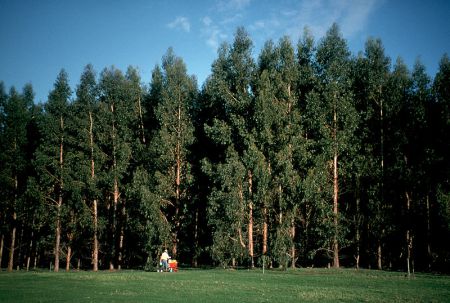 In the 1920s, when Ireland became independent, it was thought to have just 220,000 acres (90,000 hectares) of woods, covering about 1% of the land. Once-extensive forests had been shrinking for centuries…In 2017, though, almost 11% of Ireland is covered with forest, and an unknown additional amount by small woods and scattered trees. The government’s target is to cover 18% of the land area with forests by 2046. Ireland is behind schedule. Still, about 6,000 hectares of new forest ought to be planted this year, while almost none will be lost. It is part of a broad trend: the foresting of the West.
In the 1920s, when Ireland became independent, it was thought to have just 220,000 acres (90,000 hectares) of woods, covering about 1% of the land. Once-extensive forests had been shrinking for centuries…In 2017, though, almost 11% of Ireland is covered with forest, and an unknown additional amount by small woods and scattered trees. The government’s target is to cover 18% of the land area with forests by 2046. Ireland is behind schedule. Still, about 6,000 hectares of new forest ought to be planted this year, while almost none will be lost. It is part of a broad trend: the foresting of the West.
Trees are spreading in almost every European country. Because many of these forests are young, the quantity of wood in them is growing faster than their extent. Europe’s planted forests put on a little more than 1.1m cubic metres of wood per day. For comparison, the iron in the Eiffel Tower is about 930 cubic metres. Russia’s forests spread more slowly in percentage terms between 2005 and 2015, but, because Russia is so big, more than in the entire European Union in absolute terms. Forests now occupy a third of America’s land, having grown by 2% in the past decade. They are even expanding in Australia, following a long decline.
Deforestation in South America and Africa rightly gets most of conservationists’ attention. That loss is huge—equivalent to about 4.8m hectares a year, which far outweighs gains elsewhere. Yet the foresting of rich countries is still one of the world’s great land-use changes. It seems just as unstoppable as the deforestation of poorer places. It has plenty of critics, too.
The growth of forests is partly a result of changes to food markets. As the best farming areas have become more productive, and as rich countries have imported more of their food, marginal land has become unusable for ordinary agriculture…Forests are also growing because governments have favored them through laws and subsidies….Since the 1990s environmental considerations have weighed more heavily. Forests are increasingly valued as sponges for heavy rain, as wildlife habitats and as carbon sinks…
Planted forests are far from universally popular, though. Between June and October 2017, forest fires in Spain and Portugal killed more than 100 people and darkened Europe’s skies. The fires were partly blamed on the spread of non-native trees, especially eucalyptus. That Australian import, which was planted with support from the World Bank, among others, grows so quickly that trees can be harvested for pulp when less than ten years old. It also burns readily, scattering embers far afield. Portugal’s government has begun to restrict planting, in an effort to prevent the country from turning into what one green group calls “Eucalyptugal”.
The eucalyptus tree is a scapegoat for a bigger problem, argues Marc Castellnou, a fire analyst in Spain. The real trouble is that forests in Portugal and Spain have expanded quickly, with little thought for the consequences. Well-managed eucalyptus plantations are not the biggest danger—much worse are ill-managed ones with lots of underbrush and fallen wood, and the impromptu forests that grow on abandoned farms. The fires that get going in such forests jump to the treetops and burn so energetically that they cannot be stopped.
In Ireland, the criticisms are different. The country’s default tree is the sitka spruce, a fast-growing, damp-tolerant conifer from America’s Pacific Northwest. Spruce plantations are said to be devoid of life—vertical deserts of dark green. They are accused of wrecking rural communities and driving farmers off the land….
The first charge is false. Mark Wilson of the British Trust for Ornithology says that conifer plantations support more bird life per hectare than farmland, largely because they harbour more insects. Inevitably, some birds benefit more than others. The march of conifers across Britain and Ireland has increased the numbers of pine-loving birds such as siskins and crossbills. Conifers are also loved by crows—which is less obviously good, because crows raid the nests of rare birds such as curlews.
The second accusation, that trees push out other kinds of agriculture, is only partly true. Forestry subsidies and regulations have indeed distorted Ireland’s land market.
Excerpts from The Foresting of the West, Economist, Dec. 2, 2017,at 51
